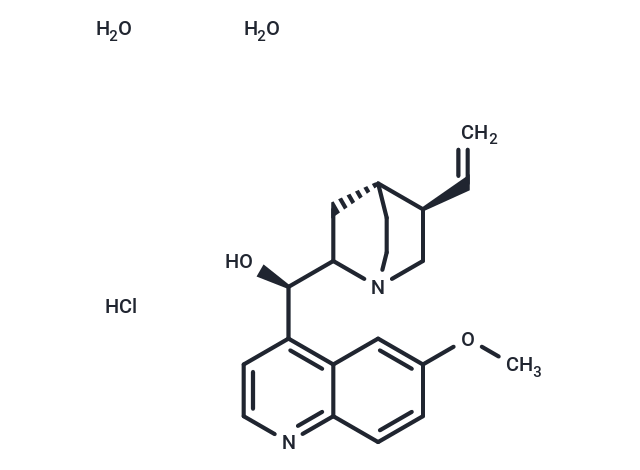Shopping Cart
- Remove All
 Your shopping cart is currently empty
Your shopping cart is currently empty

Quinine hydrochloride dihydrate (Quinine HCl Dihydrate) is a white crystalline K+ channel blocker, used to treat malaria.

| Pack Size | Price | Availability | Quantity |
|---|---|---|---|
| 1 mL x 10 mM (in DMSO) | $29 | In Stock |
| Description | Quinine hydrochloride dihydrate (Quinine HCl Dihydrate) is a white crystalline K+ channel blocker, used to treat malaria. |
| In vitro | Quinine blocks Cx36 and Cx50 junctional currents in a reversible and concentration-dependent manner with half maximal blocking concentrations of 32 mM and 73 mM, respectively. Quinine induces slow transitions between open and fully closed states that decreased open probability of the channel. Quinine thus offers a potentially useful method to block certain types of gap junction channels, including those between neurons that are formed by Cx36. [1] Quinine, a K+ channel blocker, prevents formation of tumor necrosis factor (TNF) as well as the subsequent hepatic DNA fragmentation and liver enzyme leakage. [2] Quinine elicits Fos-like immunoreactivity (FLI) concentrated in the medial third of the nucleus; acid elicited more broadly distributed FLI concentrated farther laterally. [3] Quinine has a relatively weak effect on doxorubicin accumulation but was able to completely restore doxorubicin sensitivity in the resistant cells. Quinine also modifies the intracellular tolerance to doxorubicin, which suggests that it is able to modify drug distribution within the cells. [4] Quinine primarily blocks the whole cell potassium currents (IK) in a voltage-dependent manner. Quinine also reduces the size of sodium currents (INa) in a use-dependent manner, while leaving calcium currents (ICa) relatively unaffected. [5] |
| Alias | Quinine HCl Dihydrate |
| Molecular Weight | 396.91 |
| Formula | C20H24N2O2·HCl·2H2O |
| Cas No. | 6119-47-7 |
| Smiles | O.O.Cl.COc1ccc2nccc([C@@H](O)C3C[C@H]4CCN3C[C@@H]4C=C)c2c1 |
| Relative Density. | no data available |
| Storage | Powder: -20°C for 3 years | In solvent: -80°C for 1 year | Shipping with blue ice. | |||||||||||||||||||||||||||||||||||
| Solubility Information | DMSO: 50 mg/mL (125.97 mM), Sonication is recommended. Ethanol: 79 mg/mL (199.04 mM), Sonication is recommended. H2O: 43 mg/mL (108.34 mM), Sonication is recommended. | |||||||||||||||||||||||||||||||||||
Solution Preparation Table | ||||||||||||||||||||||||||||||||||||
H2O/DMSO/Ethanol
| ||||||||||||||||||||||||||||||||||||

Copyright © 2015-2025 TargetMol Chemicals Inc. All Rights Reserved.